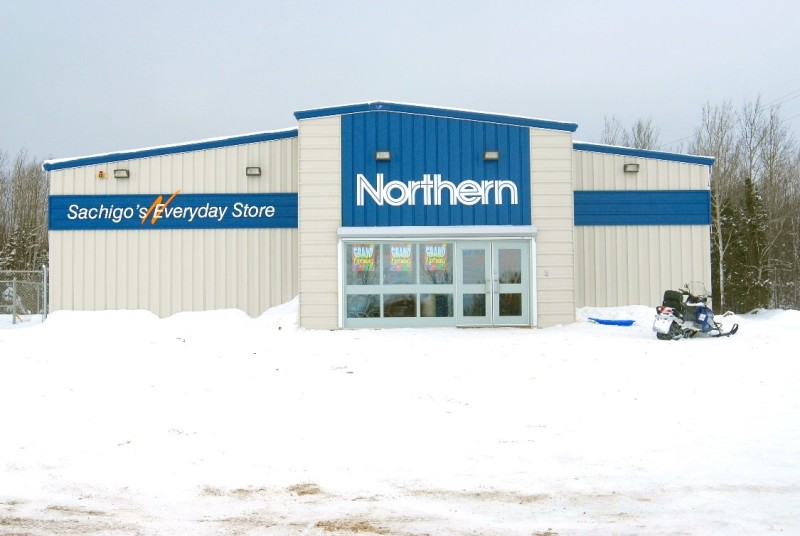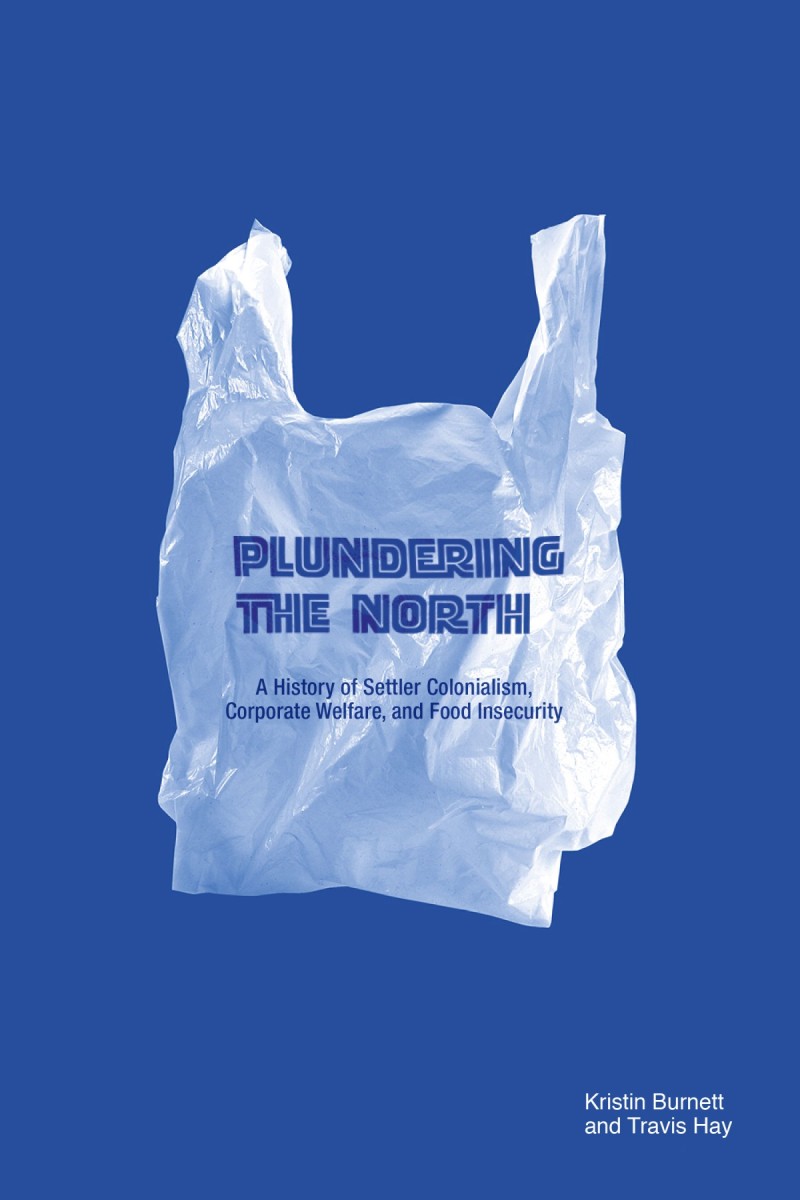The settler colonial origins of food insecurity in Canada’s North
Food insecurity in the North is one of Canada’s most shameful public health and human rights crises
Economic CrisisIndigenous PoliticsHuman RightsFood and Agriculture

Northern Store location in Sachigo Lake, Ontario. Photo courtesy the North West Company.
The following is an excerpt from the forthcoming book, Plundering the North: A History of Settler Colonialism, Corporate Welfare, and Food Insecurity, by Kristin Burnett and Travis Hay. The book provides fresh insight into Canada’s settler colonial project by re-evaluating northern food policy and laying bare the governmental and corporate processes behind the chronic food insecurity experienced by northern Indigenous communities. Plundering the North will be released in October 2023. For more information, visit www.uofmpress.ca.
I think it’s just the cost, really. I mean, how can I say this? You know: I am relatively healthy and I try to feed my family in a reasonably healthy way, but I buy ice cream, you know? … but like: it’s eleven dollars for a tub of ice cream. And so, it’s just the overall amount of money that families have to spend on food… It’s over fifty percent of your household budget. And that was based on somebody else’s nutritious food basket estimate. Most people don’t want to eat, necessarily, that food.
—Sarah, community member
Sarah (a pseudonym) is a member of a fly-in First Nation in the geographic area now known as northern Ontario who works to address access to and the affordability of market-based foods in her community. She and her partner are also active harvesters and share the foods they harvest with extended family and friends. Sarah lives out a community reality of securing wider access to food for her family and those around her, but is an autonomous individual who makes her own decisions about what it means to live “well” or “healthy.” She is also a person of some privilege in her community: Sarah is well educated, lives in a dual-income household, and helps operate a food market that brings fresh foods at cost into her community on a bi-weekly basis. Nevertheless, food access remains a significant concern for Sarah and her family.
Sarah’s community has a Northern Store—a retail chain operated by the North West Company (NWC), the successor of the Hudson’s Bay Company (HBC). The Northern Store is frequently the only full serve grocery store in many First Nation and Inuit communities located in northern Canada. The food sold at the Northern Store in Sarah’s First Nation is exorbitantly expensive—at least double the cost of the same food sold in southern Canada.
The NWC has consolidated a near monopoly on food sales in the Canadian North and expanded its operations in the early 21st century to include financial and banking services, medical and pharmaceutical services, bottled and purified water sales, as well as postal operations. Even though Sarah’s First Nation runs initiatives intended to bolster Indigenous food sovereignty and security distinct from the NWC (such as harvester support programs), they are regularly forced to rely on NWC business operations for many state-sponsored programs intended to support the health and well-being of the most vulnerable community members. Sarah explains:
As far as prenatal programs are concerned… we’re given these vouchers that can be handed out to pregnant women and women who are… breastfeeding their infant for up to one year. And those food vouchers, it’s for milk and some food. Those are only redeemable at the Northern Store… Also, one of the programs at the health centre would buy emergency supplies like diapers or that kind of thing, and that would come from the Northern Store. So, within [a local health organization], we would just request a purchase order, and that purchase order would be redeemed over there. Technically, I think we could redeem our purchase orders in the other local stores, but we don’t do that so much—well, because the Northern Store is the only full service grocery store.
In this context, it is very difficult for people to purchase food and household goods locally or run community programming without using the Northern Store.
We began with Sarah’s story because her experience with the Northern Store and, by extension, the NWC reveals the contemporary contexts in which people living in northern First Nations and Inuit communities are forced to make choices about food.
First and foremost, the cost of food and other essential goods in northern communities is prohibitive, difficult to access, and available from a very limited number of retailers. Second, what is available at northern retailers is largely predetermined by non-Indigenous people who do not live in the Canadian North. Since the Second World War, the federal government has increasingly sought to govern which foods Indigenous peoples should or should not eat, either directly through forced purchasing lists and food subsidies or indirectly through shame-based nutrition education programs and initiatives that consistently position Indigenous bodies as unhealthy and, increasingly in the latter part of the 20th century, as obese and in desperate need of intervention.

Finally, the NWC, like the federal government, dedicates a considerable amount of its resources to sanitizing its operations by employing a discursive chicanery to make it appear as if they are providing a service or “doing a favour” for northern communities that helps rather than hinders Indigenous food sovereignties.6 We interrogate how relational discourses of service provision, benevolence, and “aid” continue to permeate much of how the state, the HBC, and its successor the NWC, position themselves in Indigenous communities and in northern Canada more broadly. The Canadian government has certainly not, as it claims, “made a healthy, modern lifestyle a reality… in the magnificent yet stark wilderness” of the Canadian North, nor does it have “preserving quality and freshness down to a science.” Instead, the state has done quite the opposite by ensuring First Nations and Inuit communities who have thrived in their territories since time immemorial do so with increasing difficulty. The federal government and its exercise of colonial governance has facilitated the presence and growth of corporate interests in northern First Nations and Inuit communities.
The objective of this book, then, is to unpack the history of federal Indigenous food policies and corporate practices in the provincial and far North in so-called Canada in the post-Second World War period. We seek to elaborate upon how the state in the last century has manufactured food insecurity and retail monopolies in northern First Nations and Inuit communities. A historical examination reveals that the present-day northern retail landscape is not the result of the business acumen of the NWC’s executives or the perceived failure of Indigenous peoples to become more like European-Canadians. Instead, settler colonialism and corporate welfare have created the current food landscape.
In order to illuminate the history of this problem, we trace the partnership established between the federal government and the HBC in the late-19 and early-20th centuries, focusing in particular on the ways in which food and foodways became a technology of assimilation used by the state in their efforts to destroy the national patterns of Indigenous peoples and ultimately acquire their land. Built on the foundations of the former Northern Department of the HBC and purchased by HBC executives and private investors in 1987, the NWC currently holds a position of market dominance in most northern First Nations and Inuit communities. The NWC inherited many of the relationships and business practices developed and employed by the HBC over centuries of operations on Turtle Island. Building on the foundations laid by the HBC, the NWC leveraged their market share of food sales to include other essential services unavailable elsewhere in many northern communities, like banking and pharmacies. This business model has proven so profitable the NWC has exported it further south to rural and low-income communities in the south Pacific and Caribbean.
We think it is extremely important to understand the historical conditions of possibility that produced and maintained the current circumstances in northern Indigenous communities wherein high rates of food insecurity persist and the solutions generated by the state to address food insecurity are divorced from the systems in which they were produced. Moreover, what we are witnessing in the late-20th and early-21st centuries in the crafting of federal Indigenous policy are neoliberal ideologies where “the notion of free market rationalities” have come to inform state food policy, its proposed solutions, and the bodies upon which those policies and solutions are imposed. In other words, notions of “individualism, privatization, and decentralization reign supreme.” Such cold rationalities lie in direct op- position to the operation of Indigenous food sovereignties. By placing the discourses of the programs and government officials alongside the histories of state and corporate practices in the North, we can see how the settler state comes to understand itself as a benevolent, scientifically minded, and modern government through its project of assimilating Indigenous food systems to settler strategies of grocery shopping and market-based food consumption.
Kristin Burnett is a professor in the Department of Indigenous Learning at Lakehead University. A settler scholar, Burnett has published broadly on topics related to Indigenous health and well-being, and much of her current research and policy work engages with systemic barriers to health care, social services and supports, and food.
Travis Hay is a historian of Canadian settler colonialism who was born and raised in Thunder Bay, Ontario. He is currently an assistant professor at Mount Royal University, the author of Inventing the Thrifty Gene, and the English Language Book Review Editor of Canadian Journal of Health History.










